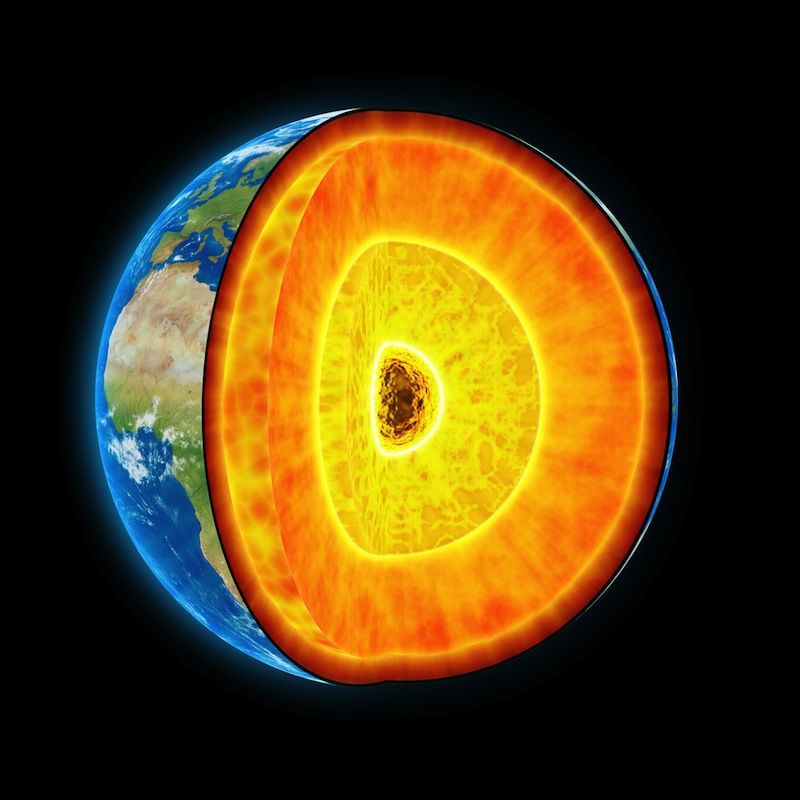
The Pluto-size ball of solid iron that makes up Earth's inner core formed between 1 billion and 1.5 billion years ago, according to new research.
What's more, the new findings suggest that Earth's magnetic field, which is powered by the swirling flow of liquid iron surrounding the inner core, could continue going strong for quite a while, said study co-author Andy Biggin, a paleomagnetism researcher at the University of Liverpool in England. (Paleomagnetism is the study of the record of the Earth's magnetic field in rocks, sediment or archaeological materials.)
"The theoretical model which best fits our data indicates that the core is losing heat more slowly than at any point in the last 4.5 billion years and that this flow of energy should keep the Earth's magnetic field going for another billion years or more," Biggin said in a statement. [Photo Timeline: How the Earth Formed]
Heart of iron
The first rocky bits of Earth coalesced around 4.54 billion years ago, less than 100 million years after the solar system formed. For much of those early years, Earth was a blob of molten rock, but over time, the surface cooled and formed a crust that floated on the Earth's liquid core. In time, the Earth developed an atmosphere, life, and the rest is, well, history.
At some point in this process, the liquid iron churning at the heart of the planet froze. Exactly when, however, remained a matter of hot debate; some scientists said it formed just 500 million years ago, while others said it formed about 2 billion years ago.
This so-called nucleation of the inner core is important because the planet's frozen heart helps power Earth's magnetic field, which shields life from harmful radiation from solar wind.
Sign up for the Live Science daily newsletter now
Get the world’s most fascinating discoveries delivered straight to your inbox.
Swirling magnetism
The strength of the magnetic field is proportional to the movements of magnetic iron churning within the molten outer core. This motion is driven by convection, a swirling heat-transfer process that occurs as the outer core loses heat to the Earth's mantle, the rocky layer sandwiched between the core and Earth's crust. Convective heat loss jumped markedly when the core froze, leading to a stronger magnetic field, the researchers said in the statement.
But exactly when this process occurred was never sorted out. To answer this question, Biggin and his colleagues looked at a database that tracked the orientation and intensity of magnetic particles in ancient rocks. Based on that data, they found a huge increase in the Earth's magnetic field between 1.5 billion and 1 billion years ago.
What's more, this giant ball of iron at the planet's heart is growing, to the tune of 0.04 inches (1 millimeter) in diameter per year, the researchers reported today (Oct. 7) in the journal Nature.
"This finding could change our understanding of the Earth's interior and its history," Biggin said.
The surprising longevity of Earth's geodynamo, as well as the inner core's glacial pace of cooling, is in stark contrast with that on Mars. A strong magnetic field once blocked streams of solar wind on the Red Planet, but that field vanished after just 500 million years. The lack of protection from solar radiation could explain why Earth is teeming with life, while Mars (may) harbor no life at all, according to a July study in the journal Science.
Follow Tia Ghose on Twitterand Google+. Follow Live Science @livescience, Facebook & Google+. Original article on Live Science.

Tia is the managing editor and was previously a senior writer for Live Science. Her work has appeared in Scientific American, Wired.com and other outlets. She holds a master's degree in bioengineering from the University of Washington, a graduate certificate in science writing from UC Santa Cruz and a bachelor's degree in mechanical engineering from the University of Texas at Austin. Tia was part of a team at the Milwaukee Journal Sentinel that published the Empty Cradles series on preterm births, which won multiple awards, including the 2012 Casey Medal for Meritorious Journalism.










